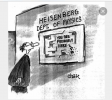- Joined
- Oct 4, 2021
- Messages
- 2,540
No disrespect, but:With respect, that isn't correct.
The mathematics of climate, and climate change, were discovered by Ed Lorenz in 1961 when he found thatclimate can be described by the types of equations that govern fluid dynamics which are nonlinear and "chaotic". These equations require the solution of Navier-Stokes equations for the atmosphere and are extremely sensitive to changes in initial parameters ( the "butterfly effect") and measurement errors so that tiny uncertainties and errors are magnified to the point where prediction is impossible. Nobody has solved these Navier Stokes equations for the atmosphere and nobody has managed to properly model clouds ( and several other things ) so according to Lorenz ( before he died ) climate prediction may be impossible, but even if it is possible, as some scientists think, even they concede we are not there yet: the same math that will solve problems with black holes and containing plasma in fusion generators, which we do not yet have, will be necessary.
The models used today are linear approximations. Climate is deterministic, which is a problem since we don't have solutions to determinitic equations, so they are increasingly stochastic, which inserts randomness rather than chaos, two very different things. The models in practice are NOT accurate and depend on many assumptions set out in the footnotes to the IPCC studies including, for example, linearity, which is, of course, a bogus assumption for a nonlinear system, and bandaid fixes like deep water warming, never observed - plus the data are constantly revised to correct the models retroactively, which would get an undergrad disciplined.
Intuition says pumping greenhouse gasses into the atmosphere must result in some warming but since CO2 is a very small component f greenhouse gasses it can only force change in a nonlinear/chaotic process which defies intuition, as Lorenz described. Prediction is about the math, and we don't have the math.
If you want to discuss this in greater detail we have been discussing this for years in detail with references in the PA.
-----------
In developing a theory to explain the ice ages, Arrhenius, in 1896, was the first to use basic principles of physical chemistry to calculate estimates of the extent to which increases in atmospheric carbon dioxide (CO2) will increase Earth's surface temperature through the greenhouse effect.[4][26][27] These calculations led him to conclude that human-caused CO2 emissions, from fossil-fuel burning and other combustion processes, are large enough to cause global warming. This conclusion has been extensively tested, winning a place at the core of modern climate science.[28][29] Arrhenius, in this work, built upon the prior work of other famous scientists, including Joseph Fourier, John Tyndall and Claude Pouillet. Arrhenius wanted to determine whether greenhouse gases could contribute to the explanation of the temperature variation between glacial and inter-glacial periods.[30] Arrhenius used infrared observations of the moon – by Frank Washington Very and Samuel Pierpont Langley at the Allegheny Observatory in Pittsburgh – to calculate how much of infrared (heat) radiation is captured by CO2 and water (H2O) vapour in Earth's atmosphere. Using 'Stefan's law' (better known as the Stefan–Boltzmann law), he formulated what he referred to as a 'rule'. In its original form, Arrhenius's rule reads as follows:
if the quantity of carbonic acid increases in geometric progression, the augmentation of the temperature will increase nearly in arithmetic progression.
Here, Arrhenius refers to CO2 as carbonic acid (which refers only to the aqueous form H2CO3 in modern usage). The following formulation of Arrhenius's rule is still in use today:[31]
{\displaystyle \Delta F=\alpha \ln(C/C_{0})}

where {\displaystyle C_{0}}






-----------
No one claims that the models are perfect, but they are holding up pretty well.
In a nutshell, climate change theory was developed years before the effect became noticeable, and it explains the observations we're seeing. As far as I know, none of the skeptics who doubt the theory have a credible *alternative* theory that explains the observed phenomena.


